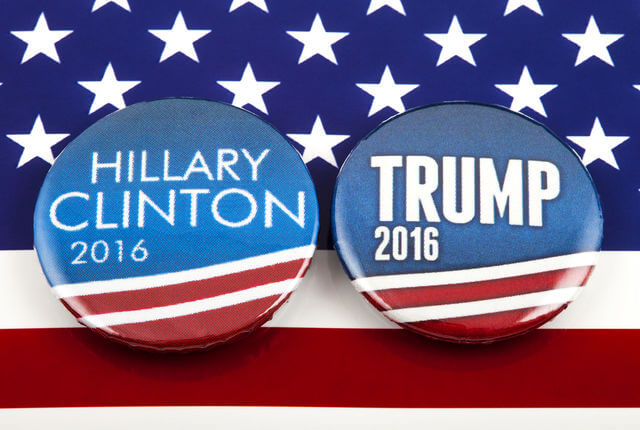
We are in the midst of what is undeniably a very contentious election season. The purpose of this post is not to discuss my personal politics or who I may or may not support in November. What I would like to do is compare and contrast a single political ad from each candidate and declare a winner based solely on the merits of the advertisements. This means I’ll do my best to leave any personal bias out of the equation and provide analysis, as an expert in the field of video production, in regards to the effectiveness of the ads, their production value and the skill of the editing and execution. I should point out that this exercise is purely to provide a discussion of creative concepts and the video production techniques used to execute them. This article does not represent the opinion of ECG Productions, nor any of its partners or staff. The declaration of a winner here does not represent an endorsement of a particular candidate, simply my personal opinion as to which ad is the most effective from a video production perspective.
Now that all that’s out of the way, on to the ads themselves. I chose the two ads that have gotten the most airplay and been the most discussed online to date. Trump started his TV advertising campaign much later in the game, so I didn’t have as many options to choose from there. For that reason, I wasn’t able to pit two ads of the same length against each other. Trump’s “Two Americas” spot is a :30 and Clinton’s “Role Models” spot is a :60, so I’ll leave the length out as a metric for evaluation. Let’s take a look at the Trump ad first:
Donald Trump: “Two Americas”
We open on a fairly unflattering shot of Hillary, framed to the far left (get it?): muted colors, sickly cool/greenish skin tone, wrinkled skin, a pretty severe look on her face. The Capitol building is hazy and out of focus in the right of the frame, likely to evoke disconnection and isolation from Trump and the right-wing, who ostensibly have the country’s best interests at heart. A somber piano track plays as an older white male VO begins, “In Hillary Clinton’s America, the system stays rigged…”. Right out of the gate, this is a pretty familiar political advertisement format: an authoritative voiceover leads us through the shortcomings of the opposing candidate. There’s a reason why this is an oft-used trope in political advertising: it’s accessible and it gets right to the point. It’s also likely familiar to an older viewer who has been through his or her fair share of election seasons. With older, caucasian voters traditionally being more right-leaning, this isn’t an approach that actively courts younger swing voters or minorities – this one seems to be aimed squarely at Trump’s base.
There’s a flash-frame transition as the cut continues. Next we see desaturated footage of a polling place, then cut to an unhappy-looking female waiting in a long line to vote. The text, “system rigged” flashes on screen over the images – no coincidence, as Trump hasn’t been shy about voicing his concerns about a rigged election and voter fraud. Next we move into the meat of the ad: immigration. The color pallette continues to appear extremely desaturated as we see file footage of Syrian refugees (along with a Clinton quote about allowing 65,000 of them into the US,) followed by shots of illegal immigrants and the text, “criminals stay”. The ad continues to paint a pretty dark picture as we see surveillance-style shots of immigrants (many of their faces blurred) who are presumably getting social security, skipping the line and eating up resources and services that should be reserved for law-abiding tax payers. The bleak picture of “Hillary’s America” closes with another unflattering shot of Clinton, this time looking bored and disengaged, desaturated to the point that it’s nearly black & white, as the VO continues “…it’s more of the same, but worse.”
We hear a cymbal roll as we transition to the the second half of the ad and the second America: “Trump’s America”. The change-over is punctuated by a heroic-sounding bell chime that could be ringing out from the Liberty Bell itself. Immediately the images we see are deeply saturated, the colors vibrant, as we open on a military helicopter banking imposingly, with text animating out from the center of the screen with a flourish and a lens flare reading, “Donald Trump’s America Is Secure”. The somber piano track is replaced by an upbeat and uplifting symphonic piece, heavy on the strings. We hear tactical radio chatter and see the watchful eye of a serviceman wearing a headset, looking down from the chopper and keeping the peace. Next we cut to a border patrol vehicle accelerating across a desert landscape, followed by a wide shot showing the same vehicle in pursuit of a silver SUV, with the shadow of a helicopter providing air-support from above. The camera cuts to an illegal immigrant being apprehended, and finally a heavily-armed border guard in full camo fatigues. We see strong, bold phrases animate on screen, laid out in the same red, white and blue treatment seen in the official Trump/Pence logo, reading, “Terrorists Kept Out”, followed by, “The Borders Secure”. The contrast from the first half of the ad is stark as we cut to feel-good shots of ethnically-diverse families, accompanied by the phrase, “Our Families Safe”. Then it’s on to the big finish: a majestic shot of an aircraft carrier at sunset, followed by Donald himself in his trademark red “Make America Great Again” trucker hat, with the standard, “I’m Donald Trump and I Approve This Message” audio tag.
The message here is pretty clear: In Trump’s America, military might and strong immigration controls will keep you safe. In Hillary’s America, illegal immigrants will run wild, criminals and terrorists will have free reign and chaos will ensue.
Pros: It’s simple and the messaging is crystal clear. The treatment of the footage, audio/sound design and pacing of the edit are all effective. It packs a good bit of information into 30 seconds.
Cons: It’s not terribly edgy. This is about as textbook as a political ads gets. That said, it’s well executed and follows a tried and true formula. I’m just not sure this approach will resonate much beyond Trump’s existing base.

Hillary Clinton: “Role Models”
Hillary’s spot, on the other hand, opens with the voice of her opponent. We hear what is to be the first of many familiar Trump quotes that have dominated the national news cycle in recent months. The first one is about Trump loving the “old days” when someone who disrupted a rally would “be carried out on a stretcher”. As the quote plays, we hear a soft, emotional piano tune over peaceful early-evening exterior shots of what we can assume is suburban America. Next we cut to the interior of one particular home in “Everytown, USA” where two children are silhouetted by the glow of a television set. The lighting is contrasty and the color palette is cool, evoking early evening across America. We can imagine mom and dad in the next room preparing dinner, or maybe helping an older brother or sister with their homework. Next we see a series of kids of various races in close-up, their eyes fixed on the screen that we haven’t seen yet, light playing across their transfixed faces. The first few expressions are fairly blank, but when we cut to a particularly sad looking little girl, her eyes slightly moist, the next Trump quote plays: “…and you can tell them to go <bleep> themselves”. Donald appears on screen long enough to bare his teeth as he prepares to deliver the expletive, then a hard cut on the censor’s bleep as we cut to two frightened-looking young boys, mouths agape as they watch in stunned silence.
I’d be lying if I said this wasn’t pretty hard-hitting upon my first viewing. I’m a parent myself, with a six-year-old daughter and a two-year-old son at home, and this definitely struck a chord. The production value and shot selection are spot on and the rhythm of the editing is tight, but the big win here is that it accomplishes the goal every video editor strives for: it elicits an emotional response. I definitely felt something when the camera cut to the two shocked kids on the couch, and that’s saying something for a political ad.
The ad continues for the next 30 seconds or so (this spot is a :60, as you’ll recall), working its way through a “greatest hits” list of Trumps most notorious quotes that anyone not living under a rock this past year has heard literally hundreds of times, all under the gaze of innocent, intently watching children. When Trump quips about being able to, “stand in the middle of Fifth Avenue and shoot somebody” and not lose any voters, we see a child framed from behind, cutting to that angle just in time for the partially obscured figure on screen to point his “finger gun” directly at the forehead of the child and pull the imaginary trigger. From there we cut to the face of an angry looking Latino girl, her jaw set as she glares at the screen listening to the now infamous quote about Mexican immigrants, “…they’re bringing drugs, they’re bringing crime, they’re rapists.” We cut mid-quote to a wide-eyed caucasian boy, hair still wet from his bath as he hides his face behind a towel.
The ad continues on with this formula, intercutting familiar soundbites about, “blood coming out of her wherever” and Trump’s over-the-top imitation of a disabled journalist, all with children watching silently in their respective living rooms. It’s undeniably effective and we’ve now reached the 40-second mark without any audio other than Trump himself. The technique works because it doesn’t editorialize, at least not directly. The order of the images and the juxtaposition of Trump and children certainly leads the viewer toward a particular interpretation of the footage, but it doesn’t hit them over the head with how they should be reacting. The relative subtlety contrasts sharply with the VO and text-led approach seen in the “Trump: Two Americas” ad. The piano track swells emotionally as we fade to black, with basic white titles fading on screen in succession: “Our children are watching” followed by “What example will we set for them?”.
Honestly, if the ad ended here, I think it would be pretty effective. This also means you probably could create a solid :30 from this material if you wanted to. Instead, we move into a coda of sorts, with Hillary herself reiterating the sentiment of the titles: that we need to make sure our children, who will be watching this election play out in real time, can be proud of us. The presentation is the same, but now it’s Hillary on the television as various children watch silently, their expressions decidedly more upbeat and inspired. It’s a solid sentiment and it still works, I’m just not sure you need to tack on the “Hillary as Heroine” ending as it makes everything feel a bit too on the nose. The strength of the first two-thirds of the spot, in my opinion, is that it has more finesse and subtlety than the Trump ad. We close with the standard, “I’m Hillary Clinton, and I approve this message” outro.
The message here is clear, but the viewer has the sense that they’ve been led to the conclusion more organically: this election is bigger than us and our personal politics. We need to take a step back from the unprecedented contentiousness of this election and choose a leader who can conduct herself with poise and dignity (nevermind the fact that we’ve all had pretty frequent glimpses into the warts-and-all Hillary that likely lurks behind the dignified public persona).
Pros: It employs a non-traditional approach that uses Trump’s own, unedited words against him. It elicits a strong emotional response that will be relatable to a broad range of voters.
Cons: It undercuts its own strengths a bit by switching to a more traditional political ad approach for the closing third of the spot.
The Verdict:
Both ads are well-executed and effective in their own right. The production value may be slightly higher in the Hillary piece, but that’s not really the differentiator here. What separates these ads is their creative approach. Trump’s is very safe and Hillary’s is edgier – somewhat ironic since their respective campaigns are the exact opposite. While I clearly understood the messaging of Trump’s ad immediately, it didn’t really make me feel anything visceral. I knew I was supposed to be afraid and outraged, but it felt very abstract. Hillary’s ad, on the other hand, felt more even-handed (though it really wasn’t) because it at least appeared to present facts and let the viewer come to their own decision. It’s essentially the difference between showing (Hillary) and telling (Trump). For that reason, if I was basing my vote solely on these two ads and nothing else, I’d have to go firmly with a nod to Hillary. While the production, editing and execution are strong for both ads, the creative is undeniably better in Hillary’s.
So there you have it. What did you think of these two ads? Do you disagree with my appraisal? Let us know in the comments below, we’d love to hear from you!
As always, thanks for reading!

